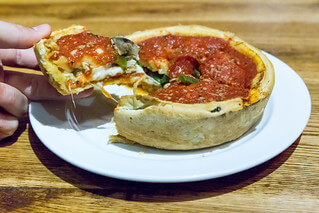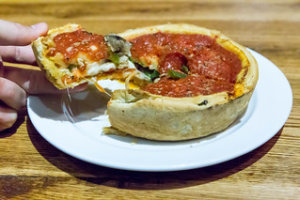
If you have ever sunk your teeth into a Chicago-style deep-dish pizza, you surely must remember the savory experience your taste buds indulged in: generous layers of meat, vegetables, and gooey, melty mozzarella cheese, all married together with a sauce of crushed tomatoes and held by a crispy-on-the-outside, flaky and buttery crust. This American classic is the hearty version of the traditional flatbread pizza and is perfect for those who really love the toppings aspect of the pizza-eating experience.
Believe or not, you too can recreate this iconic Chicago-style dish at home — and you don’t need to be an expert pizzaiolo (Italian for pizza maker).
Roots of Deep-Dish Pizza
Have you ever wondered about the meaning of one of the most popular words in the culinary world? The root of “pizza” comes from the Italian word “pinsere,” which means to pound or stamp, in reference to the flat dough used in the original pizza. The earliest known reference to flatbread dates back to 997 AD, appearing in a Latin text near the southern Italian city of Lazio. Fast-forward 500 years, and what we now call pizza began to appear in the Italian city of Naples.
This pizza prototype was an inexpensive staple for the poor Neapolitan working class. Pizza was paper-thin, baked in an oven, and sold on the streets. Newly discovered tomatoes from the New World were used to top the dough, which was also covered with anchovies, garlic, or cheese. Eventually, pizza spread across the Italian landscape, even reaching the higher social strata. The infamous Pizza Margherita was created in honor of the Queen of Italy, Margherita of Savoy, and to this day it continues to be one of the classic versions of pizza.
Deep-dish pizza was born in Chicago, the result of a long tradition of pizza-making brought to the United States in the late 1800s and early 1900s by Neapolitan immigrants. Although there is no defining documentation on the exact origin of deep-dish pizza, the most common version is that two entrepreneurs, Ike Sewell and Ric Riccardo, created this classic Italian-American dish in 1943.
Deep-Dish Versus Neapolitan Pizza

“Chicago-style Pizza with Salami and Mushrooms” licensed under CC BY 2.0 via Flickr by marcoverch
Reinventing the classic Neapolitan version, this new style of pizza had a deeper dish, crunchier crust, and inverted layers of toppings. In contrast to flatbread-type pizza, deep-dish pizza resembles a pie more than anything, but uses a thin to medium crust in its recipes.
The pizza is baked in an iron skillet or a round, steel pan resembling a cake or pie pan. The cooking vessel is oiled to facilitate removal and give the crust a nice crunch. Although its usually made with wheat flour, deep dish pizza dough can also include cornmeal or semolina, which give the crust a yellow hue. The dough can be pressed or rolled and shaped into the pan, making sure the sides are covered as well.
Baking time is longer than a traditional pizza, due to the generous layers of toppings. To avoid burning the cheese during the baking process, it is placed on the dough first and is followed by the addition of meat, such as pepperoni or sausage, and vegetable toppings such as onions, mushrooms, and bell peppers. Everything is then covered by an uncooked sauce, which is made from crushed canned tomatoes. A layer of parmesan cheese may be added for additional flavor.
Making Your Own Deep-Dish Pizza
Now that you have an understanding of how deep-dish pizza is made, it’s time to put theory to practice. The whole process should take approximately two to three hours, which includes time for the rising of the dough. Most ingredients can be found at your regular grocery store, although you are welcome to shop at an Italian specialty store for items such as cheese and canned tomatoes.
Preparing the Dough
This recipe will yield two pizzas. For the dough, you will need the following ingredients:
- 3 1/2 cups all-purpose flour
- 1/4 cup cornmeal
- 1 package (1/4 ounce) quick-rise yeast
- 1 1/2 teaspoons sugar
- 1/2 teaspoon salt
- 1 cup water
- 1/3 cup olive oil
In a large bowl, combine 1 1/2 cups flour, the cornmeal, yeast, sugar, and salt. Heat the water and oil in a saucepan to 120 degrees Fahrenheit and add to the dry ingredients, beating until a moistened mass has formed.
Add the remaining flour to form a stiff dough and place onto a floured surface. Knead the dough until its smooth and elastic, about six to eight minutes. Place in a greased bowl and turn the dough ball once to grease the top. Cover the bowl and let dough rise in a warm place until double in size.
Once the dough has expanded, punch it dough down and divide in two. Roll out each portion into an 11-inch circle and press the dough onto the bottom and sides of two greased 10-inch cast-iron skillets (use cake pans as substitutes).
Preheat the oven to 450 degrees Fahrenheit.
Layering the Toppings
For the toppings, you will require the following ingredients (you may substitute or add vegetables of your choice):
- 4 cups shredded part-skim mozzarella cheese
- 1 can (28 ounces) well-drained, diced tomatoes
- 1 can (8 ounces) tomato sauce
- 1 can (6 ounces) tomato paste
- 1/2 teaspoon salt
- 1/4 teaspoon each garlic powder, dried oregano, dried basil and pepper
- 1 pound bulk Italian sausage, cooked and crumbled
- 48 slices pepperoni
- 1/2 pound sliced fresh mushrooms
- 1/4 cup grated Parmesan cheese
Begin by layering each pizza crust with 2 cups of mozzarella cheese. Next, add half of the sausage, pepperoni, and mushrooms to each pizza.
To make the tomato filling, combine the tomatoes, tomato sauce, tomato paste, and seasonings. Cover each pizza with half of the tomato mixture and sprinkle with 2 tablespoons of the grated Parmesan cheese.
Baking
Cover loosely with aluminum foil to prevent heavy browning and bake at 450 degrees Fahrenheit for 35 minutes. Uncover and bake until lightly browned, approximately five minutes longer. Let the pizzas cool on a wire rack for 10 minutes. Slice, serve, and enjoy!
Curious to see how your homemade version compares to a restaurant-quality pizza? You can always stop by or order from Chicago’s best deep-dish pizza restaurant, Pequod’s Pizza, at one of our two locations in Chicago and Morton Grove.